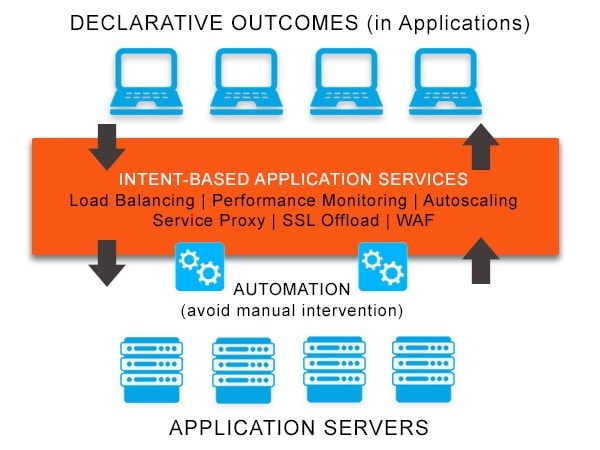Intent-based Application Services Definition
Intent-based application services focus on outcomes instead of inputs, delivering a pool of software services to applications to ensure a fast, scalable and secure application experience. Application services include load balancing, application performance monitoring, web application firewalls, application acceleration, autoscaling, micro‑segmentation, and service discovery needed to optimally deploy, deliver, run, and monitor applications.

What Are Intent-based Application Services?
Intent-based application services refer to functions like load balancing, web application firewall and container ingress that focus on outcomes instead of inputs. They work in a declarative, or outcome-based mode.
Declarative — or outcome-based — systems are the opposite of those that are imperative, or input-based. For example, an intent-based load balancer will automatically focus on the outcome of adapting to changes in traffic by auto-scaling up or down without manual intervention. An input-based load balancer requires manual reconfigurations when there are changes to the application, infrastructure or traffic.
What Are Intent-based Application Services Used For?
Intent-based application services can include but not limited to load balancing, security, analytics, web application firewall and container ingress. A software load balancer is the most common application. To be intent-based (declarative) instead of input-driven (imperative), load balancers should be designed around the following principles:
• Multi-Cloud: An intent-based load balancer should be able to provide services across all environments including bare metal, VMs or containers whether they are deployed in on-prem data centers or cloud environments (public clouds like AWS, Azure, GCP or private clouds like OpenStack).
• Intelligence: Visibility and analytics are critical for ensuring security and to drive automation. An intent-based load balancer uses artificial intelligence to provide insights into applications, infrastructure and traffic. The value of automation is best manifested when combined with intelligence.
• Automation: The load balancer must integrate seamlessly with other clouds, platforms and tools. If you have to write custom automation scripts for each application or for each infrastructure environment, then you do not have an intent-based load balancer. Load balancers with software-defined architecture are designed specifically drive automation that is not possible with traditional appliances. And software-defined load balancers provide turnkey automation in any environment.
What Are the Benefits of Using Intent-based Application Services?
The benefit of using intent-based application services, such as L4-L7 load balancers, is not having to manually configure and deploy pairs of load balancers for applications. It often helps accelerate the transition to intent-based networking or as part of an organization’s digital transformation.
The initial appliance load balancers were similar to switchboards for early telephones. Every function required human interaction. Virtual editions of the hardware load balancer appliances have not been through a generational change required to adopt modern architectures. So they still require manual and error-prone input when infrastructure, applications or traffic change.
Does Avi Offer Intent-based Application Services?
Avi Networks delivers Intent-based Application Services by automating intelligence and elasticity across any cloud. Intent-based is based on a declarative model that allows you to focus on the desired business outcomes by specifying intent. It frees you from repetitive and error prone manual inputs, which represent the imperative model of the past. Avi does the heavy lifting in the application services delivered to you with built-in analytics and full automation so you can focus on innovation. The applications services delivered include software load balancing, web application security, and ingress gateway for container-based microservices applications.
For more on the actual implementation of load balancing, security applications and web application firewalls check out our Application Delivery How-To Videos.
For more information on intent-based application services see the following resources: